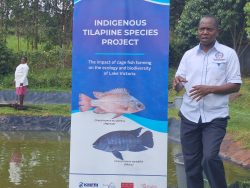
By Bertila Nyanchama and Jane Naitore (KNA)
The Kenya Marine and Fisheries Research Institute (KEMFRI) has launched a study aimed at boosting the population of endangered indigenous fish species to enhance food security.
The two species, Ngege and Mbiru, were once the dominant catches in Lake Victoria in the 1950s but are now on the verge of extinction.
The fish, also known as Tilapia Singida and Victoria Tilapia respectively, were key in the diets of local communities before the introduction of Nile Perch and Nile Tilapia, the now dominant species.
KEMFRI’s Assistant Director of Aquaculture, Dr Paul Orina, said there is need to restore the native species to diversify food sources and reduce dependency on Nile Perch and Tilapia.
Dr Orina, who was speaking at Kegati Aquaculture Centre in Kisii County, said that the introduction of non-native species like the Nile Perch significantly contributed to the decline of indigenous fish populations.
“Our goal is to research and conserve the genetic material of Ngege and Mbiru to reintroduce them into the lake, creating a sustainable food sources that lessens reliance on just a few species,” he stated.
The research, supported by Boston University, Rio Fish and PlusFish Philanthropy, focuses on evaluating the performance and nutritional value of Ngege and Mbiru.
The objective is to determine if the species can outperform the Nile Tilapia in terms of nutrition and sustainability, potentially contributing to Kenya’s broader food security goals.
Dr Orina emphasised that the research further aims to assess the adaptability of the fish to aquaculture practices, particularly in fish cages and ponds.
Kenya’s efforts are part of the larger regional collaboration with Uganda and Tanzania, aligning with Sustainable Development Goal 17, which promotes partnerships in research across East Africa.
Together, the countries aim to integrate the species into the regional aquaculture industry.
According to Dr Orina, human activity, such as waste from growing cities around Lake Victoria, including Kisumu, Mwanza and Jinja, as well as the use of harmful fishing practices, have affected the fish populations.
To address these challenges, Dr Orina proposed implementing selective breeding programmes similar to those used for Nile Tilapia, to enhance the performance of Ngege and Mbiru in aquaculture environments.
The study is a significant step towards safeguarding Kenya’s aquatic biodiversity while also providing new opportunities for sustainable economic growth and food security.
